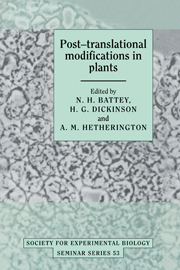Book contents
- Frontmatter
- Contents
- List of contributors
- List of abbreviations
- Preface
- Some roles of post-translational modifications in plants
- Signal transduction and protein phosphorylation in bacteria
- Roles of protein phosphorylation in animal cells
- The significance of post-translational modification of proteins by phosphorylation in the regulation of plant development and metabolism
- Post-translational modification of chloroplast proteins and the regulation of protein turnover
- Purification of a small phosphoprotein from chloroplasts and characterisation of its phosphoryl group
- Use of synthetic peptides to study G proteins and protein kinases within plant cells
- Activation of membrane-associated protein kinase by lipids, its substrates, and its function in signal transduction
- Distribution and function of Ca2+-dependent, calmodulin-independent protein kinases
- Phosphorylation of the plasma membrane proton pump
- The regulation of phosphoenolpyruvate carboxylase by reversible phosphorylation
- Protein phosphorylation and circadian rhythms
- Control of translation by phosphorylation of mRNP proteins in Fucus and Xenopus
- Regulation of plant metabolism by reversible protein (serine/threonine) phosphorylation
- Detection, biosynthesis and some functions of glycans N-linked to plant secreted proteins
- Biosynthesis, intracellular transport and processing of ricin
- Post-translational processing of concanavalin A
- The role of cell surface glycoproteins in differentiation and morphogenesis
- Ubiquitination of proteins during floral development and senescence
- Index
Activation of membrane-associated protein kinase by lipids, its substrates, and its function in signal transduction
Published online by Cambridge University Press: 06 July 2010
- Frontmatter
- Contents
- List of contributors
- List of abbreviations
- Preface
- Some roles of post-translational modifications in plants
- Signal transduction and protein phosphorylation in bacteria
- Roles of protein phosphorylation in animal cells
- The significance of post-translational modification of proteins by phosphorylation in the regulation of plant development and metabolism
- Post-translational modification of chloroplast proteins and the regulation of protein turnover
- Purification of a small phosphoprotein from chloroplasts and characterisation of its phosphoryl group
- Use of synthetic peptides to study G proteins and protein kinases within plant cells
- Activation of membrane-associated protein kinase by lipids, its substrates, and its function in signal transduction
- Distribution and function of Ca2+-dependent, calmodulin-independent protein kinases
- Phosphorylation of the plasma membrane proton pump
- The regulation of phosphoenolpyruvate carboxylase by reversible phosphorylation
- Protein phosphorylation and circadian rhythms
- Control of translation by phosphorylation of mRNP proteins in Fucus and Xenopus
- Regulation of plant metabolism by reversible protein (serine/threonine) phosphorylation
- Detection, biosynthesis and some functions of glycans N-linked to plant secreted proteins
- Biosynthesis, intracellular transport and processing of ricin
- Post-translational processing of concanavalin A
- The role of cell surface glycoproteins in differentiation and morphogenesis
- Ubiquitination of proteins during floral development and senescence
- Index
Summary
Biochemical signal transduction is a term used for chains, or rather for networks, of reactions induced by chemical or physical signals. Chemicals as signals in plants may originate internally, for instance hormones or other compounds acting at low concentrations, or externally, for instance by cell–cell interactions (Scherer, 1990a). Typical physiological signals (besides hormones) in plants are gravity, light or touch. Usually, signal transduction reactions are triggered by a conformational change induced by binding of the signalling molecule or by other induced physical changes to a receptor structure, which are in turn transduced by conformational changes in proteins interacting with the receptor structure. A typical reaction chain in eukaryotic signal transduction leads from a membrane-bound receptor to interactions with G proteins, which may activate or inhibit second-messenger-generating enzymes (Gilman, 1984). The enzymes known to generate second messengers in animal cells are phospholipase C, phospholipase A2 and phospholipase D, all of which generate lipid breakdown products as second messengers, and adenylate cyclase and guanylate cyclase, which generate cAMP and cGMP, respectively. Cytosolic Ca2+ ions also function as second messengers, the concentration of which is regulated by several processes, including the action of other second messengers. Hence, it is more correct to envisage signal transduction in plants as a network rather than as a linear chain of reactions.
Second messengers often activate protein kinases specifically, and these in turn can regulate enzymatic activities by regulatory phosphorylation, leading eventually to cellular responses (Ranjeva & Boudet, 1987).
- Type
- Chapter
- Information
- Post-translational Modifications in Plants , pp. 109 - 122Publisher: Cambridge University PressPrint publication year: 1993
- 5
- Cited by

